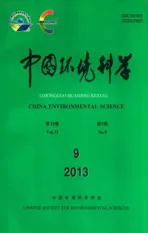我国环境中PFOS的预测无效应浓度
2013-01-18张亚辉周腾耀王一喆刘征涛
张亚辉,曹 莹,周腾耀,2,王一喆,刘征涛*
(1.中国环境科学研究院,环境基准与风险评估国家重点实验室,北京 100012;2.桂林理工大学环境科学与工程学院,广西 桂林 541004)
全氟辛烷磺酸(PFOS)广泛用于纺织、消防、日用洗涤、皮革等领域[1].各种含有PFOS产品的大量使用,造成其进入到环境介质如水[2-5]、底泥[6]、土壤[7],在生物体内[8-9]和人体[10]中也能发现 PFOS的存在.研究表明,PFOS对环境生物产生毒性作用[11-13],对生态环境存在潜在威胁.2009年斯德哥尔摩公约第四次缔约方大会把 PFOS及其盐列为9种新增POPs物质名单[14].目前我国在江苏常熟、辽宁阜新等地区建有氟化工工业园区,其中 2006~2008年 PFOS在国内年产量200t 左右[15-16],2009年比往年下降约100t[16].
目前,世界各国和组织如 OECD[17]和英国[18]对 PFOS及其盐进行了毒害评估或环境风险评估;荷兰 RIVM[19]和美国明尼苏达州[20]分别设定了 PFOS的水质基准限值以防止其对水生态环境造成不利影响.国内,刘超等[21]对镀铬企业周边PFOS的环境风险进行了初步评价.
在推导 PFOS的预测无效应浓度(PNEC)值时,英国采用巴西尼康虾(Mysidopsis bahia)的慢性毒性数据,获得水体的PNEC值25μg/L[18];美国采用黑头呆鱼(Pimephales promelas)的数据,获得淡水 PNEC 值为 30μg/L[22].采用国外 PFOS的PNEC值,对我国本土生物可能产生“欠保护”或“过保护”影响,不利于我国 PFOS的环境风险评估.然而,采用我国本土生物物种的毒性数据,推导PFOS在我国环境介质中PNEC值尚未见有报道.本研究采用欧盟现有化学物质风险评价技术指导文件(TGD)[23]中计算 PNEC方法,对我国水环境和土壤环境中 PNEC值进行推导,为我国开展PFOS的环境风险评价提供科学基础.
1 生态毒性数据与PNEC计算方法
1.1 生态毒性毒性数据筛选
PFOS的生态毒性数据来自国内外已发表文献和报告.PFOS的生物毒性数据包括PFOS及其钾盐、锂盐和铵盐,原则上选择我国已有的生物种,包括外来引进物种如虹鳟鱼等,舍弃外国物种如黑头呆鱼等.
数据评估参照欧洲化学管理局(ECB)现有化学物质的数据评估方法[23].对淡水生物,水生生物的毒性数据应该涵盖生态系统的 3个营养级(藻、溞、鱼),其中藻类等植物的毒性指标至少为72h以上的半数效应浓度EC50或半致死浓度LC50,蚤类急性毒性指标是48h EC50或LC50,鱼类急性毒性指标采用96h LC50;慢性毒性指标是无观察效应浓度NOEC.对于底栖生物,主要关注寡毛类(水蚯蚓)、水生昆虫、软体动物(贝类等)的急性和慢性毒性指标.对于土壤生物,主要关注陆生植物出芽、生长等急性指标LC50和慢性毒性指标 NOEC;土壤无脊椎动物如蚯蚓和跳虫的急性致死LC50和慢性繁殖毒性指标NOEC;土壤微生物主要关注对土壤菌群的慢性毒性效应.
所有毒性数据要求有明确的测试终点、测试时间以及对测试阶段或指标的详细描述,尽量选择较新文献中毒性数据.
1.2 环境PNEC推导方法
1.2.1 淡水水体 PNEC计算方法 根据获得的水生生物毒性数据量,分别选择评估因子法和统计外推法推导水体中PNEC值.其中评估因子根据获得的急性与慢性毒性数据的不同情况分别选择100、100、10、50、10推导PNEC;如果满足至少8个不同生物种类的10个NOEC(最好大于 15个)的最小数据集要求,则可通过物种敏感度曲线(SSD)法进行统计外推计算 5%毒害浓度HC5,然后根据情况选择1~5评估因子计算PNEC值;如果有野外试验或模拟生态系统的毒性数据,根据实际情况选择评估因子计算PNEC水值[23].
对于间歇性排放,采用急性毒性数据计算PNEC水,至少满足3个不同营养水平(藻、溞、鱼)的短期毒性数据,评估因子选择100.
淡水沉积物 PNEC计算方法 如果无法获得沉积物生物毒性数据,利用平衡分配法计算PNEC沉积物,公式(1)[23]如下:

式中: PNEC水为水中的预测无效应浓度,mg/L;RHO悬浮物为悬浮物的湿体积密度,kg/m3;K悬浮物-水为悬浮物水分配系数,m3/m3; PNEC沉积物为沉积物的PNEC值,mg/kg.
如果获得沉积物毒性数据,采用评估因子法计算PNEC
沉积物,如表 1.
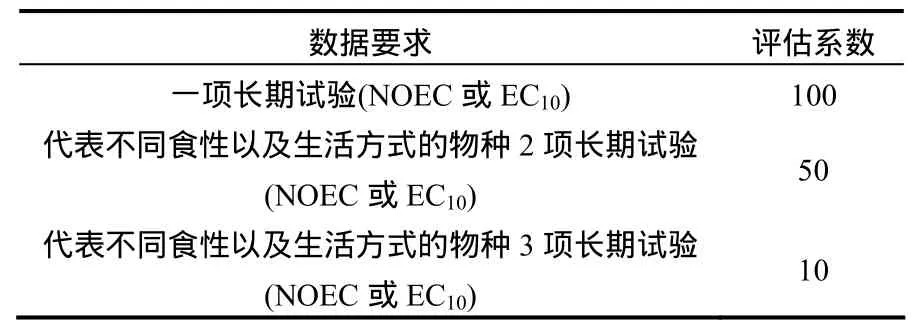
表1 推导PNEC沉积物的评估因子[23]Table 1 Assessment factors for devivation of PNECsed[23]
如果仅获得一项沉积物急性毒性数据,则应用评估系数1000计算PNEC沉积物,同时应用平衡分配法计算 PNEC沉积物,两种方法计算得到 PNEC沉积物较低值用于风险表征.
1.2.2 土壤中 PNEC计算方法 由于土壤生物利用率以及毒性效应与土壤性质有关,不同类型土壤试验数据不能相比较,因此应将试验结果转化为标准土壤数据.NOEC与 LC50的校正公式(2)[23]如下:

式中:Fom
土壤(标准)为标准土壤中有机质的比率kg/kg,默认值为 3.4%;Fom土壤(试验)为试验土壤中的有机质比率kg/kg.
如果无法获得土壤生物毒性数据,利用平衡分配法计算 PNEC土壤,公式(3)[23]如下:

式中:RHO土壤为土壤的湿体积密度,kg/m3;K土壤-水为土壤水分配系,m3/m3; PNEC土壤为土壤的 PNEC值,mg/kg.
如果获得土壤毒性数据,采用评估因子法计算 PNEC土壤,如表 2.
如果仅获得一项土壤生物毒性数据,同时应用评估因子法与平衡分配法计算,选择 PNEC土壤较低值用于风险表征.

表2 推导PNEC土壤的评估因子[23]Table 2 Assessment factors for devivation of PNECsoil[23]
2 环境PNEC值
2.1 淡水水体PNEC水
PFOS对水生生物的急性和慢性毒性数据见表 3. PFOS对水生生物的急性毒性数据包括大型植物、绿藻、甲壳类动物、软体动物、两栖类动物、环节动物和鱼,共34个毒性数据.慢性毒性数据包括大型植物、绿藻、昆虫和鱼类,共计44个毒性数据(NOEC),包括藻、溞、鱼3个营养级的水生生物,因此选择评估因子10计算PNEC水.如表3所示,藻、溞、鱼的NOEC数值最小值为日本青鳉14d生殖率0.1mg/L[24],得到PNEC水为0.01mg/L.然而,PFOS对 14d日本青鳉的幼体成活率NOEC值低于0.01mg/L[24];在摇蚊幼虫36d慢性试验中,以总体羽化率为毒性终点,NOEC值小于 0.0023mg/L[25].此外,在 PFOS对心斑绿蟌120d试验中,幼体成活率和觅食成功率NOEC值为0.01mg/L[26-27].由此可见,PENC值0.01mg/L对这些水生生物“欠保护”.因此,本文采用心斑绿蟌120d幼体成活率NOEC值0.01mg/L[26],除以评估因子10,得到PNEC水为0.001mg/L.
对于间歇式排放,采用急性毒性数据最低值为5.6mg/L[24](夹杂带丝蚓96h LC50),除以评估因子100, PNEC值为0.056mg/L.
2.2 淡水沉积物PNEC沉积物
由于缺乏 PFOS的沉积物毒性数据,采用平衡分配法计算PNEC沉积物.采用文献[18]报道的河流沉积物中吸附-解吸系数Kd为8.7L/kg,按照TGD中标准环境特征参数,忽略PFOS在水体悬浮物与气体的分配,计算得到K悬浮物-水为 3.08m3/m3, RHO悬浮物采用 TGD 默认值1150kg/m3.按照式(1)得到 PNEC沉积物为 2.7mg/kg(湿重).
2.3 土壤PNEC土壤
PFOS对土壤生物的急性和慢性毒性数据如表4所示.慢性数据中包括7种植物3个毒性终点的NOEC值和2种土壤跳虫的28d LC50值.植物慢性毒性试验中黑麦草 21d NOEC值3.91mg/kg为最低值[28],应用评价因子 100,计算得到PNEC
土壤为 0.039mg/kg(湿重).采用 OECD试验标准,默认有机质含量 3%(Fom土壤(试验)),通过公式(2),将NOEC值(3.91mg/kg)转化为标准土壤数据 NOEC(标准)为 3.51mg/kg,得到 PNEC土壤(标准)为0.035mg/kg(湿重).在表4中PFOS对土壤跳虫的21d慢性试验中[29],设置0.05,0.1,1,10mg/kg 4个浓度,得到 LC50为 0.05mg/kg,PNEC土壤(标准)为0.035mg/kg可能会对F. fimetaria的繁殖产生不良影响.PFOS对另一种跳虫F. candida的28d慢性试验中,试验浓度为 0.05,0.2,0.4,1mg/kg, 28d LC50为0.13mg/kg[29],其中0.05mg/kg与对照组无明显差异,可视为NOEC值,采用评估因子50,获得 PNEC土壤为 0.001mg/kg(湿重).
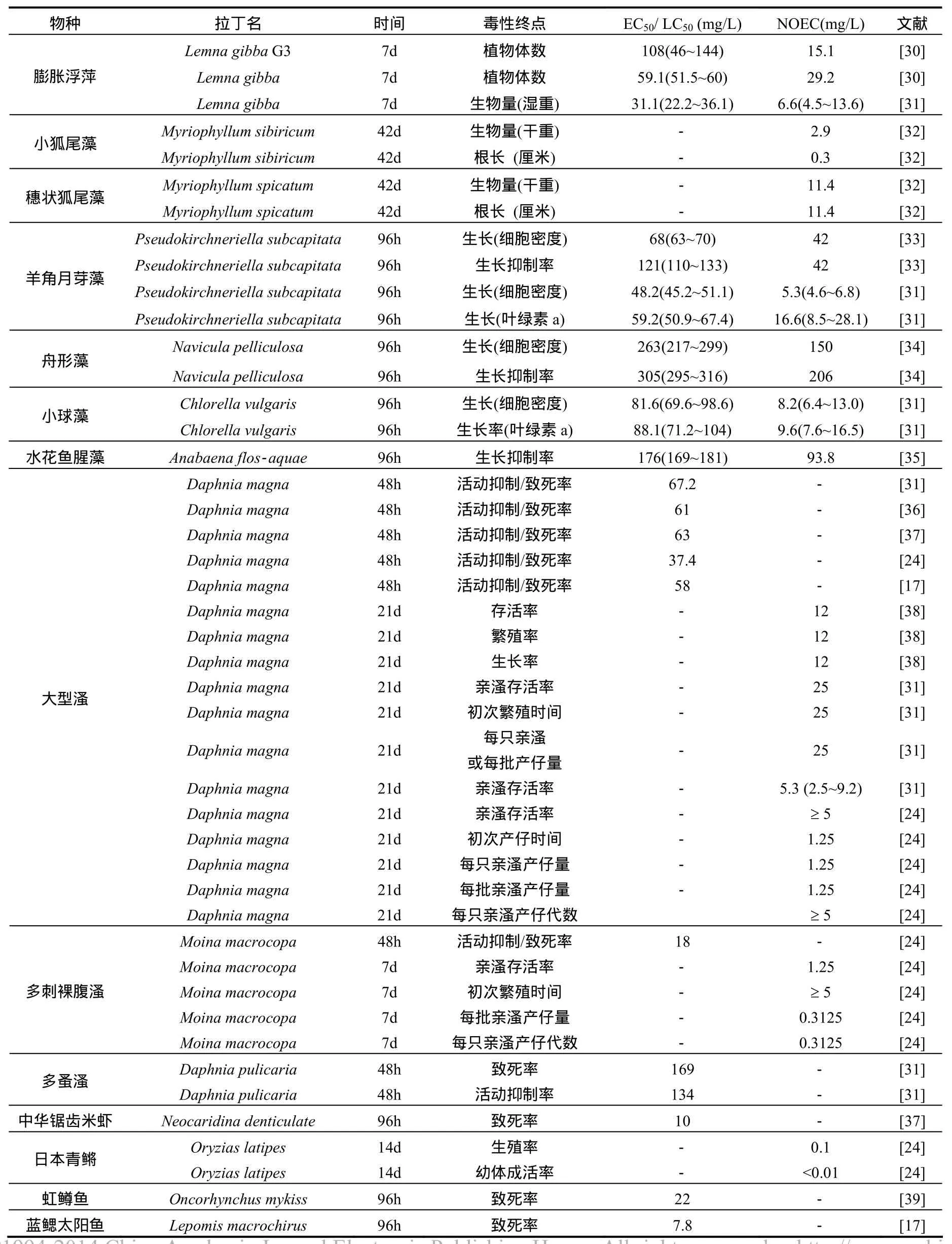
表3 PFOS对水生生物的急性和慢性毒性数据Table 3 Acute and chronic toxicity data of PFOS for freshwater species
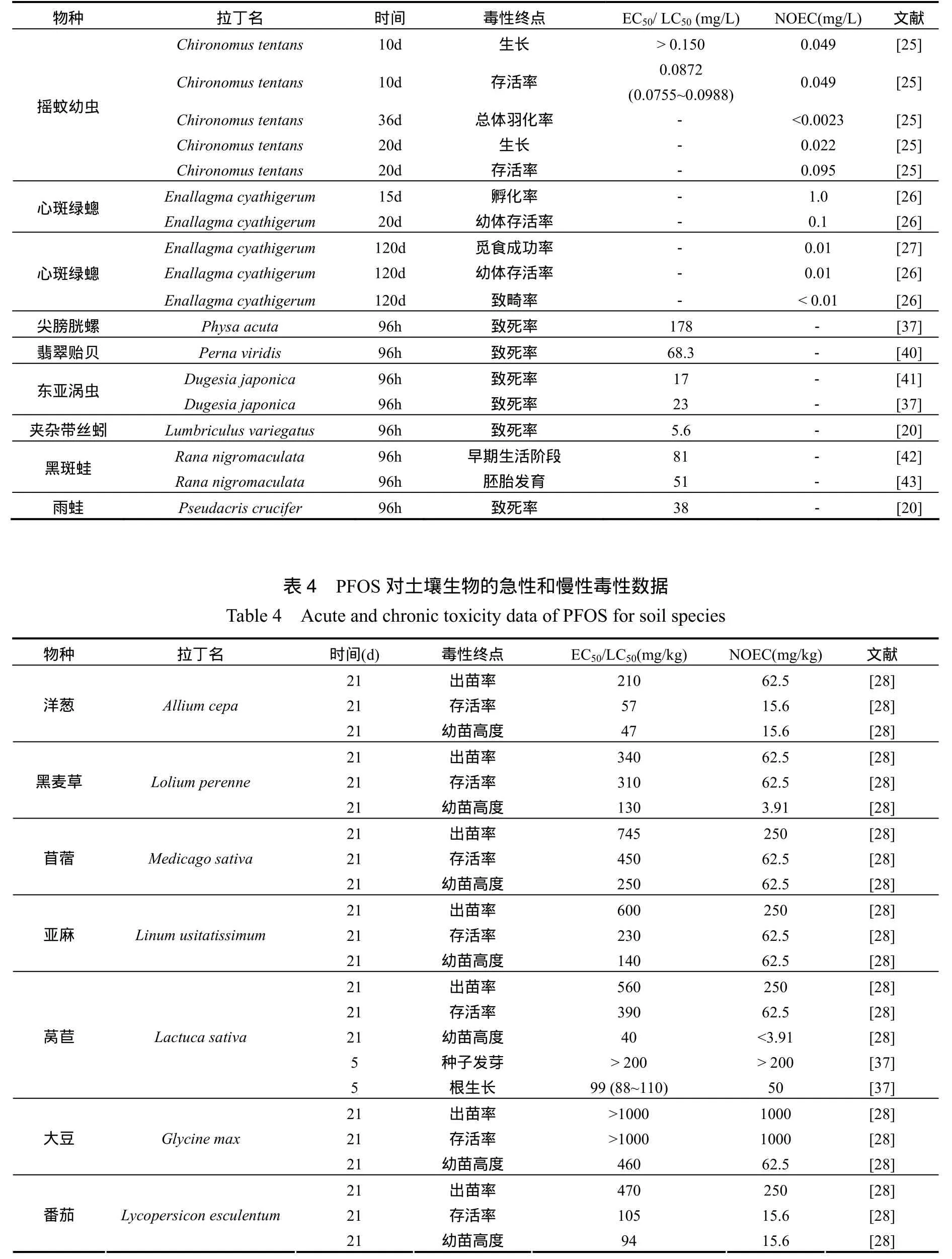
续表3
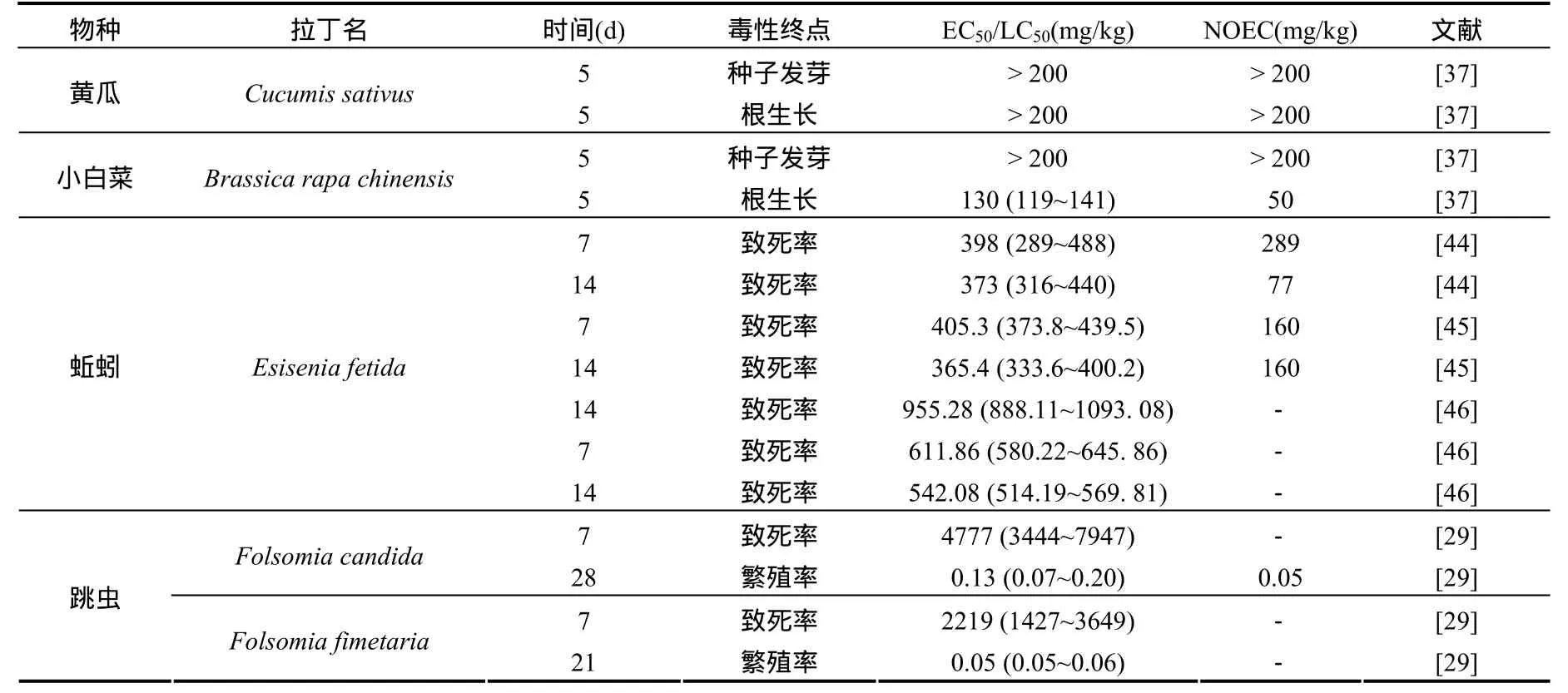
续表4
3 讨论
PFOS对不同环境介质的 PNEC值见表 5.英国环境署2004年对PFOS的环境风险进行了评估[18],采用巴西尼康虾(Mysidopsis bahia) 35d NOEC值,获得PNEC为25μg/L.2010年3M公司重新评估了该报告,认为采用巴西尼康虾在海水中的毒性数据,推导淡水PNEC值不合适,尽管在欧盟TGD中没有明确陈述海水毒性数据不能推导淡水 PNEC.因此利用黑头呆鱼(Pimephales promelas) 42d NOEC值0.3mg/L,除以评估因子10,获得淡水 PNEC 为 30μg/L[22].然而,这 2 个PNEC 值对昆虫(摇蚊幼虫 36d NOEC<0.0023mg/L[25]和心斑绿蟌 120d NOEC=0.01mg/L[22]),以及鱼类(日本青鳉 14d NOEC<0.01mg/L[24]),显然不能保护.另外,Qi等[47]采用 4种方法推导了 PFOS在淡水中 PNEC值,除了PNEC水为0.61µg/L外,其余PNEC值均不能对摇蚊幼虫产生足够的保护.本文中采用心斑绿蟌120d NOEC=0.01mg/L[22],推导出 PNEC水=1 μg/L,目前对查到的所有淡水生物(表 3)是能够足够保护的.
另外,由于PFOS的PNEC沉积物是通过平衡分配法来计算的,PNEC水大小造成该值不同.然而,有研究对采用平衡分配法计算 PFOS的PNEC沉积物是否合适,尚存在疑问[18].因此,需要进一步补充 PFOS的沉积物毒性数据,确保PNEC沉积物对我国底栖生物的保护.
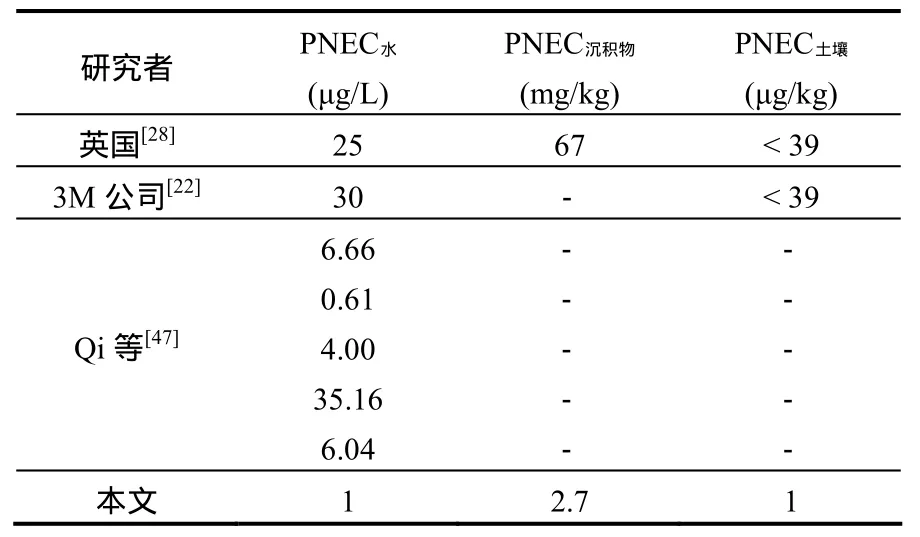
表5 环境中PFOS的预测无效应浓度(PNEC)Table 5 The PNEC values of PFOS in the environment
在推导土壤 PNEC值,英国[18]采用莴苣 21d NOEC值<3.91应用评估因子100,获得PNEC土壤为 39μg/kg,毒性数据没有采用(2)进行校正.3M公司也采用了这一数值,但同时指出,如有新的数据可替代该数值.本文采用我国文献中报道的土壤跳虫(F.candida)28dNOEC 值(0.05mg/kg)推导了PNEC土壤[29].该文献试验方法采用ISO标准试验方法,但由于试验中未报道试验土壤的有机质含量和含水率,因此本文未对该毒性数据进行标准化处理,因此可能造成PNEC土壤数值偏低.
4 结论
4.1 通过选择 PFOS对我国生物种的生态毒性数据,计算PFOS在淡水和土壤的PNEC值分别为 1.00μg/L 和 1μg/kg (湿重).
4.2 由于缺乏PFOS的沉积物毒性数据,PNEC沉积物是根据平衡分配法计算得到 2.7μg/kg (湿重).需要补充 PFOS的沉积物毒性数据,确保对我国底栖生物足够地保护.
[1] Giesy J P, Kannan K. Perfluorochemical surfactants in the environment [J]. Environmental Science and Technology,2002,36(7):146A-152A.
[2] 金一和,刘 晓,秦红梅,等.我国部分地区自来水和不同水体中的PFOS污染 [J]. 中国环境科学, 2004,24(2):166-169.
[3] Yang L P, Zhu L Y, Liu Z T. Occurrence and partition of perfluorinated compounds in water and sediment from Liao River and Taihu Lake, China [J]. Chemosphere, 2011,83(6):806-814.
[4] So M, Miyake Y, Yeung W, et al. Perfluorinated compounds in the Pearl River and Yangtze River of China [J]. Chemosphere, 2007,68(11):2085-2095.
[5] 李 飞,曾庆玲,沈春花,等.上海市市政污水中全氟有机酸污染特征 [J]. 中国环境科学, 2012,32(9):1602-1612.
[6] Zhao L X, Zhu L Y, Yang L P, et al. Distribution and desorption of perfluorinated compounds in fractionated sediments [J].Chemosphere, 2012,88(11):1390-1397.
[7] Sepulvado J G, Blaine A C, Hundal L S, et al. Occurrence and fate of perfluorochemicals in soil following the land application of municipal biosolids [J]. Environmental Science and Technology,2011,45(19):8106-8112.
[8] Yang L P, Tian S Y, Zhu L Y, et al. Bioaccumulation and distribution of perfloroalkyl acids in seafood products from Bohai Bay, China [J]. Environmental Toxicology and Chemistry, 2012,31(9):1972-1979.
[9] Taniyasu S, Kannan K, Horii Y, et al. A survey of perfluorooctane sulfonate and related perfluorinated organic compounds in water,fish, birds, and humans from Japan [J]. Environmental Science and Technology, 2003,37(12):2634-2639.
[10] Olsen G W, Huang H Y, Helzlsouer K J, et al. Historical comparison of perfluorooctanesulfonate, perfluorooctanoate, and other fluorochemicals in human blood [J]. Environmental Health Perspectives, 2005,113(5):539-545.
[11] Drottar K R, Krueger H O. PFOS: A 96-hr static acute toxicity test with the saltwater mysid (Mysidopsis bahia) [R]. Wildlife International, Ltd. Project No. 454A-101, EPA Docket AR226-0095. 2000.
[12] Drottar K R, Krueger H O. PFOS: A flow through life-cycle toxicity test with the saltwater mysid (Mysidopsis bahia) [R].Wildlife International, Ltd., Project No. 454A-107,EPA Docket AR226-0101.2000.
[13] Wilkins P. Perfluorooctane sulfonate, potassium salt (PFOS): An acute oral toxicity study with the honeybee [R]. Environmental Biology Group, Central Science Laboratory: Sand Hutton, York,UK, 2001.
[14] Wang T, Wang Y W, Liao C Y, et al. Perspectives on the inclusion of perfluorooctane sulfonate into the stockholm convention on persistent organic pollutants [J]. Environmental Science and Technology, 2009,43(14):5171-5175.
[15] Wang B, Huang J, Deng S B, et al. Addressing the environmental risk of persistent organic pollutants in China [J]. Frontiers of Environmental Science and Engineering in China, 2012,6(1):1-15.
[16] 吴广龙,余立风,胡 乐,等.我国削减并逐步替代全氟辛烷磺酸盐(PFOS)的策略与建议 [J]. 生态毒理学报, 2012,7(5):477-482.
[17] OECD Hazard assessment of perfluorooctane sulfonate (PFOS)and its salts [R]. Environment Directorate. Joint meeting of the chemicals committee and the working party on chemicals,pesticides and biotechnology, 2002.
[18] Brooke D, Footitt A, Nwaogu T A. Environmental risk evaluation report: Perfluorooctanesulphonate (PFOS) [R]. United Kingdom:Environment Agency, 2004.
[19] Moermond C T A, Verbruggen E M J, Smit C E. Environmental risk limits for PFOS. A proposal for water quality strandards in accordance with the water framework directive [R]. RIVM report 601714013/2010. 2010.
[20] Stevens J B, Coryell A. Surface water quality criterion for perfluorooctane sulfonic acid [R]. Minnesota Pollution Control Agency St. Paul, Minnesota. STS Project 200604796. 2007.
[21] 刘 超,胡建信,刘建国,等.镀铬企业周边全氟辛烷磺酰基化合物环境风险评价 [J]. 中国环境科学, 2008,28(10):950-954.
[22] 3M Company. Technical review and reassessment of the uk environmental risk evaluation report for perfluorooctanesulfonate(PFOS) [R]. St. Paul, MN, 2010.
[23] European Chemical Bureau. Technical guidance document on risk assessment in support of commission directive 93/67/EEC on risk assessment for new notified substances, commission regulation(EC) No 1488/94on risk assessment for existing substances, and directive 98/8/EC of the European parliament and of the council concerning the placing of biocidal products on the market [R].Office for Official Publications of the European Communities:Luxembourg, 2003.
[24] Ji K, Kim Y, Oh S, et al.Toxicity of perfluorooctane sulfonic acid and perfluorooctanoic acid on freshwater macroinvertebrates(Daphnia magnaandMoina macrocopa) and fish (Oryzias latipes)[J].Environmental Toxicology and Chemistry, 2008,27(10):2159-2168.
[25] MacDonald M M, Warne A L, Stock N L, et al. Toxicity of perfluorooctane sulfonic acid and perfluorooctanoic acid toChironomus tentans[J]. Environmental Toxicology and Chemistry, 2004,23(9):2116-2123.
[26] Bots J, De Bruyn L, Snijkers T, et al. Exposure to perfluorooctane sulfonic acid (PFOS) adversely affects the life cycle of the damselflyEnallagma cyathigerum[J]. Environmental Pollution,2010,158:901-905.
[27] Van Gossum H, Bots J, Snijkers T, et al. Behaviour of damselfly larvae (Enallagma cyathigerum)(Insecta, Odonata) after longterm exposure to PFOS [J]. Environmental Pollution, 2009,157(4):1332-1336.
[28] Brignole A J, Porch J R, Krueger H O, et al. PFOS: a toxicity test to determine the effects of the test substance on seedling emergence of seven species of plants [R]. Wildlife International,Ltd. EPA Docket AR226-1369. 2003.
[29] 张 轩,张 偲,王光鹏,等.全氟辛烷磺酸盐(PFOS)对土壤跳虫的生态毒性 [J]. 生态毒理学报, 2012,7(5):525-529.
[30] Desjardins D, Sutherland C A, Van Hoven R L, et al. PFOS: A 7-d toxicity test with duckweed (Lemna gibba G3) [R]. Wildlife International, Ltd. Project: 2001,454-111.
[31] Boudreau T M, Sibley P, Mabury S, et al. Laboratory evaluation of the toxicity of perfluorooctane sulfonate (PFOS) onSelenastrum capricornutum,Chlorella vulgaris,Lemna gibba,Daphnia magna, andDaphnia pulicaria[J]. Archives of Environmental Contamination and Toxicology, 2003,44(3):307-313.
[32] Hanson M, Sibley P, Brain R, et al. Microcosm evaluation of the toxicity and risk to aquatic macrophytes from perfluorooctane sulfonic acid [J]. Archives of Environmental Contamination and Toxicology, 2005,48(3):329-337.
[33] Drottar K R, Krueger H O. PFOS: A 96-hr toxicity test with the freshwater alga (Selenastrum capricornutum) [R]. Wildlife International, Ltd., Project Number 454A-103A, EPA Docket AR226-0085. 2000.
[34] Sutherland C, Krueger H O. PFOS: A 96-hr toxicity test with the freshwater diatom (Navicula pelliculosa) [R]. Wildlife International, Ltd., Project Number 454A-112, EPA Docket AR226-1030a055. 2001.
[35] Desjardins D, Sutherland C A, Van Hoven R L, et al. PFOS: A 96-hr toxicity test with the freshwater alga (Anabaena flos-aquae)[R]. Wildlife International, Ltd. Project Number 454A-110B,EPA Docket AR226-0186. 2001.
[36] Drottar K R, Krueger H O. PFOS: A 48-hr static acute toxicity test with the cladoceran (Daphnia magna) [R]. Wildlife International, Ltd., Project No. 454A-104, EPA Docket AR226-0087. 2000.
[37] Li M H. Toxicity of perfluorooctane sulfonate and perfluorooctanoic acid to plants and aquatic invertebrates [J].Environmental Toxicology, 2009,24(1):95-101.
[38] Drottar K R, Krueger H O. PFOS: A semi-static life-cycle toxicity test with the cladoceran (Daphnia magna) [R]. Wildlife International Ltd., Project No. 454A-109, EPA Docket AR226-0099. 2000.
[39] Palmer S, Van Hoven R L, Krueger H O. Perfluorooctanesulfonate, potassium salt (PFOS): A 96-hr static acute toxicity test with the rainbow trout (Oncorhynchus mykiss) [R]. Wildlife International Ltd. Report No. 454A-145, EPA Docket AR226-1030a044. 2002.
[40] 王贺威,马胜伟,张 喆,等.全氟辛烷磺酸盐(PFOS)胁迫对翡翠贻贝抗氧化酶的影响 [J]. 生态毒理学报, 2012,7(5):508-516.
[41] Li M H. Effects of nonionic and ionic surfactants on survival,oxidative stress, and cholinesterase activity of planarian [J].Chemosphere, 2008,70(10):1796-1803.
[42] 苏红巧,任东凯,曹 闪,等.全氟辛烷磺酸盐(PFOS)及替代品对两栖类蝌蚪的急性毒性 [J]. 生态毒理学报, 2012,7(5):521-524.
[43] 任东凯,苏红巧,刘芃岩,等.全氟烷基磺酸盐(PFOS)及其替代品对两栖类胚胎的发育毒性 [J]. 生态毒理学报, 2012,7(5):561-564.
[44] Sindermann A B, Porch J R, Krueger H O, et al. PFOS: An acute toxicity study with the earthworm in an artificial soil substrate [R].Wildlife International Ltd. Project No. 454-111. EPA Docket AR226-1106. 2002.
[45] Joung K E, Jo E H, Kim H M, et al. Toxicological effects of PFOS and PFOA on earthworm,Eisenia fetida[J]. Environmental Health and Toxicology, 2010,25(3):181-186.
[46] 徐冬梅,文岳中,李 立,等.PFOS对蚯蚓急性毒性和回避行为的影响 [J]. 应用生态学报, 2011,22(1):215-220.
[47] Qi P, Wang Y, Mu J L, et al. Aquatic predicted no-effectconcentration derivation for perfluorooctane sulfonic acid [J].Environmental Toxicology and Chemistry, 2011,30(4):836-842.
